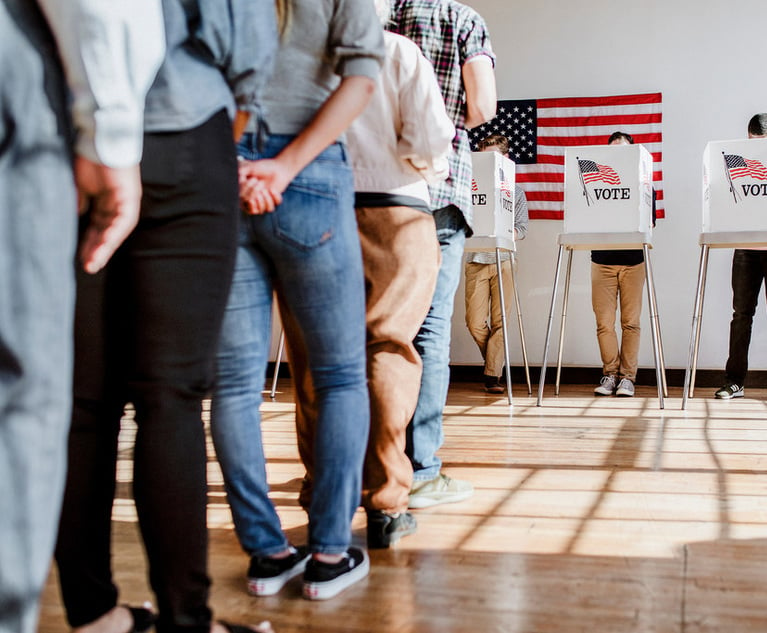E-discovery: Managing the duty to preserve voicemail
Litigants increasingly seek discovery of voicemail. In a matter in which there is a duty to preserve electronically stored information, there may also be a duty to preserve voicemail messages.
January 29, 2013 at 01:21 AM
9 minute read
The original version of this story was published on Law.com
Litigants increasingly seek discovery of voicemail. In a matter in which there is a duty to preserve electronically stored information, there may also be a duty to preserve voicemail messages. What should inside counsel do? New voicemail technologies require new ways of thinking about how to comply with a party's discovery obligations.
As a threshold matter, in-house counsel should explore whether parties are willing to stipulate that they will not exchange voicemail. Courts typically will respect and enforce such stipulations. However, when parties cannot agree to limit voicemail discovery, courts will focus on the extent to which voicemail messages are reasonably accessible or unduly burdensome to identify, preserve and produce. For example, in the July 2012 case Merial Ltd. v. Velcera, Inc., the Middle District of Georgia District Court decided that voicemail need not be preserved or collected because it was not reasonably accessible.
There are several types of voicemail systems available to companies, and the type of voicemail system a company uses will determine what steps that company should take to preserve voicemail messages. Of course, regardless of your company's system, if you have reason to believe that voicemail evidence is central to your case, it is important to consider immediately halting the company's routine deletion schedules, at least as to key witnesses, or to take other steps to preserve the evidence.
Analog and basic digital systems
Analog systems are increasingly rare. These systems store voicemails on magnetic tape located at the phone company or on tape located at the user's place of business. Preserving analog voicemail requires making copies of these tapes, or playing the message out loud and recording it onto other recording devices. Once preserved, the process of identifying relevant voicemails can require listening to audio files, which takes time and can become expensive.
The most basic type of digital voicemail is stored on its own dedicated computer server either at the phone company or at the user's place of business. The voicemails are accessible through phones, but they are not generally accessible through individual users' computers. Like analog systems, identifying relevant voicemails on this type of system can be expensive because there is generally no way to isolate relevant messages without reviewing entire audio files. In our view, these costs and burdens provide substantial support for an argument that, except in the rare case, a party should not be required to review and produce analog or basic digital voicemails.
Email alert
More advanced digital voicemail systems send an email alerting a recipient that a voicemail has arrived. In order to access the voicemail, a user must dial in to the voicemail server through a telephone. Because the emails identify the date and time a voicemail was received, the emails can later be used to isolate relevant voicemail messages on the digital server (assuming the emails and the voicemails were both preserved in their respective locations). This can significantly lower the cost of identifying relevant voicemails, and thus may make the discovery of such voicemails more cost-effective and reasonable.
Email link
Some digital voicemail systems send an email containing a clickable link directly to the voicemail, allowing the user to access the voicemail message directly from a computer. Using the link, users can download voicemails onto their computer and save them as digital audio .WAV files. Because of this ability to download the voicemail directly to a user's computer, companies that have email access voicemail systems must search beyond the voicemail server when looking to preserve voicemails.
Email attachment
The most sophisticated voicemail systems automatically send emails attaching digital copies of voicemails to recipients in the form of audio .WAV files. These emails, which typically identify the date and time a voicemail was received, commonly include the caller ID information, which can facilitate a more targeted preservation search, and the voicemails are stored on email servers (as opposed to voicemail servers) that generally preserve information for longer periods of time than other systems. Companies using this type of system have heightened preservation obligations because the emails (and the voicemail files attached to them) can easily be forwarded and may eventually reside on computers located throughout the company, as well as mobile devices.
Inside counsel should understand their companies' voicemail systems so they can effectively preserve necessary voicemails when required. The more information a voicemail system preserves and distributes to its recipients, the easier it may be to identify relevant voicemail messages later, and such systems make it increasingly difficult to argue that a company's voicemails are not reasonably accessible. Inside counsel should implement a data retention policy in order to minimize the volume of information retained and be sure to suspend that retention policy when necessary to preserve relevant data.
Litigants increasingly seek discovery of voicemail. In a matter in which there is a duty to preserve electronically stored information, there may also be a duty to preserve voicemail messages. What should inside counsel do? New voicemail technologies require new ways of thinking about how to comply with a party's discovery obligations.
As a threshold matter, in-house counsel should explore whether parties are willing to stipulate that they will not exchange voicemail. Courts typically will respect and enforce such stipulations. However, when parties cannot agree to limit voicemail discovery, courts will focus on the extent to which voicemail messages are reasonably accessible or unduly burdensome to identify, preserve and produce. For example, in the July 2012 case Merial Ltd. v.
There are several types of voicemail systems available to companies, and the type of voicemail system a company uses will determine what steps that company should take to preserve voicemail messages. Of course, regardless of your company's system, if you have reason to believe that voicemail evidence is central to your case, it is important to consider immediately halting the company's routine deletion schedules, at least as to key witnesses, or to take other steps to preserve the evidence.
Analog and basic digital systems
Analog systems are increasingly rare. These systems store voicemails on magnetic tape located at the phone company or on tape located at the user's place of business. Preserving analog voicemail requires making copies of these tapes, or playing the message out loud and recording it onto other recording devices. Once preserved, the process of identifying relevant voicemails can require listening to audio files, which takes time and can become expensive.
The most basic type of digital voicemail is stored on its own dedicated computer server either at the phone company or at the user's place of business. The voicemails are accessible through phones, but they are not generally accessible through individual users' computers. Like analog systems, identifying relevant voicemails on this type of system can be expensive because there is generally no way to isolate relevant messages without reviewing entire audio files. In our view, these costs and burdens provide substantial support for an argument that, except in the rare case, a party should not be required to review and produce analog or basic digital voicemails.
Email alert
More advanced digital voicemail systems send an email alerting a recipient that a voicemail has arrived. In order to access the voicemail, a user must dial in to the voicemail server through a telephone. Because the emails identify the date and time a voicemail was received, the emails can later be used to isolate relevant voicemail messages on the digital server (assuming the emails and the voicemails were both preserved in their respective locations). This can significantly lower the cost of identifying relevant voicemails, and thus may make the discovery of such voicemails more cost-effective and reasonable.
Email link
Some digital voicemail systems send an email containing a clickable link directly to the voicemail, allowing the user to access the voicemail message directly from a computer. Using the link, users can download voicemails onto their computer and save them as digital audio .WAV files. Because of this ability to download the voicemail directly to a user's computer, companies that have email access voicemail systems must search beyond the voicemail server when looking to preserve voicemails.
Email attachment
The most sophisticated voicemail systems automatically send emails attaching digital copies of voicemails to recipients in the form of audio .WAV files. These emails, which typically identify the date and time a voicemail was received, commonly include the caller ID information, which can facilitate a more targeted preservation search, and the voicemails are stored on email servers (as opposed to voicemail servers) that generally preserve information for longer periods of time than other systems. Companies using this type of system have heightened preservation obligations because the emails (and the voicemail files attached to them) can easily be forwarded and may eventually reside on computers located throughout the company, as well as mobile devices.
Inside counsel should understand their companies' voicemail systems so they can effectively preserve necessary voicemails when required. The more information a voicemail system preserves and distributes to its recipients, the easier it may be to identify relevant voicemail messages later, and such systems make it increasingly difficult to argue that a company's voicemails are not reasonably accessible. Inside counsel should implement a data retention policy in order to minimize the volume of information retained and be sure to suspend that retention policy when necessary to preserve relevant data.
This content has been archived. It is available through our partners, LexisNexis® and Bloomberg Law.
To view this content, please continue to their sites.
Not a Lexis Subscriber?
Subscribe Now
Not a Bloomberg Law Subscriber?
Subscribe Now
NOT FOR REPRINT
© 2025 ALM Global, LLC, All Rights Reserved. Request academic re-use from www.copyright.com. All other uses, submit a request to [email protected]. For more information visit Asset & Logo Licensing.
You Might Like
View All
GCs Must Act Now to Prepare for the Trump Administration’s First Months
8 minute read
'True Leadership Is About Putting Others First': 2024 In-House Award Winners Inspired, Took Road Less Traveled

'We Are Far From Finished': Amazon Pro Bono Program Raises Sights After Championing Justice From West Virginia to Ukraine
5 minute read
Advertising Tech Likely to Draw More Scrutiny in 2025 Over Consumers' Data, Lawyers Say
5 minute readTrending Stories
- 1GCs Must Act Now to Prepare for the Trump Administration’s First Months
- 2Appreciating the Important Work the Middlesex County Civil Bar Panel Does
- 3Patent Disputes Over SharkNinja, Dyson Products Nearing Resolution
- 4Freshfields Name Change Becomes Official
- 5Lawyers on TikTok Seek the Right Mix of Substance and Levity
Who Got The Work
Michael G. Bongiorno, Andrew Scott Dulberg and Elizabeth E. Driscoll from Wilmer Cutler Pickering Hale and Dorr have stepped in to represent Symbotic Inc., an A.I.-enabled technology platform that focuses on increasing supply chain efficiency, and other defendants in a pending shareholder derivative lawsuit. The case, filed Oct. 2 in Massachusetts District Court by the Brown Law Firm on behalf of Stephen Austen, accuses certain officers and directors of misleading investors in regard to Symbotic's potential for margin growth by failing to disclose that the company was not equipped to timely deploy its systems or manage expenses through project delays. The case, assigned to U.S. District Judge Nathaniel M. Gorton, is 1:24-cv-12522, Austen v. Cohen et al.
Who Got The Work
Edmund Polubinski and Marie Killmond of Davis Polk & Wardwell have entered appearances for data platform software development company MongoDB and other defendants in a pending shareholder derivative lawsuit. The action, filed Oct. 7 in New York Southern District Court by the Brown Law Firm, accuses the company's directors and/or officers of falsely expressing confidence in the company’s restructuring of its sales incentive plan and downplaying the severity of decreases in its upfront commitments. The case is 1:24-cv-07594, Roy v. Ittycheria et al.
Who Got The Work
Amy O. Bruchs and Kurt F. Ellison of Michael Best & Friedrich have entered appearances for Epic Systems Corp. in a pending employment discrimination lawsuit. The suit was filed Sept. 7 in Wisconsin Western District Court by Levine Eisberner LLC and Siri & Glimstad on behalf of a project manager who claims that he was wrongfully terminated after applying for a religious exemption to the defendant's COVID-19 vaccine mandate. The case, assigned to U.S. Magistrate Judge Anita Marie Boor, is 3:24-cv-00630, Secker, Nathan v. Epic Systems Corporation.
Who Got The Work
David X. Sullivan, Thomas J. Finn and Gregory A. Hall from McCarter & English have entered appearances for Sunrun Installation Services in a pending civil rights lawsuit. The complaint was filed Sept. 4 in Connecticut District Court by attorney Robert M. Berke on behalf of former employee George Edward Steins, who was arrested and charged with employing an unregistered home improvement salesperson. The complaint alleges that had Sunrun informed the Connecticut Department of Consumer Protection that the plaintiff's employment had ended in 2017 and that he no longer held Sunrun's home improvement contractor license, he would not have been hit with charges, which were dismissed in May 2024. The case, assigned to U.S. District Judge Jeffrey A. Meyer, is 3:24-cv-01423, Steins v. Sunrun, Inc. et al.
Who Got The Work
Greenberg Traurig shareholder Joshua L. Raskin has entered an appearance for boohoo.com UK Ltd. in a pending patent infringement lawsuit. The suit, filed Sept. 3 in Texas Eastern District Court by Rozier Hardt McDonough on behalf of Alto Dynamics, asserts five patents related to an online shopping platform. The case, assigned to U.S. District Judge Rodney Gilstrap, is 2:24-cv-00719, Alto Dynamics, LLC v. boohoo.com UK Limited.
Featured Firms
Law Offices of Gary Martin Hays & Associates, P.C.
(470) 294-1674
Law Offices of Mark E. Salomone
(857) 444-6468
Smith & Hassler
(713) 739-1250






